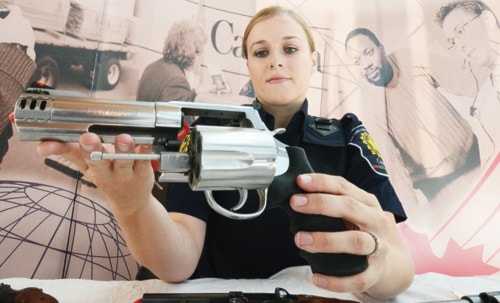Packing a Kong on his utility belt may not be a part of the official uniform, but for Canadian Border Services officer Steve Robinson, it’s essential.
His four-legged partner Jack, an explosives and drug detection dog for the region, does his best work with it.
“When he completes his goal he gets his reward, the Kong, and he loves that thing,” said Robinson.
Initial reaction to seeing the dog toy on his utility belt might draw strange looks, but so does having a giant fishing net leaning against a wall in the Osoyoos border services office.
“Oh, that is actually part of our aviation control. Sometimes we get birds in the building up in the rafters,” chuckles Michael Cacchioni, superintendent for the Port of Osoyoos.
This is a side of officers many don’t see when crossing the border into Canada. Cacchioni admits one of the biggest misconceptions of border guards is that “they are all mean.” But their stern-while-still-being-polite approach comes with reason. A display table full of just some of the seized guns and weapons from the past year proves that point.
“I think the job has changed. Historically the reason why customs was formed was for things such as revenue collection, but our focus has become a bit different — there is gun seizures, arresting people for warrants, smuggling and drugs,” said Cacchioni. “What a lot of people don’t see are these types of threats and seizures behind the scenes. They just think I’m being nickled and dimed on my extra block of cheese or whatever. They may not be privy that while they are in a 20-minute lineup to get across the border to Canada that we are executing a warrant on someone who is wanted or conducting a weapons seizure.”
One package marked as “hunting knives,” contained some very intimidating gloves sitting on the seized items table. With three, razor sharp blades about seven inches protruding from the finger area, in the style of X-men character Wolverine, these weapons were found by Canadian border guards. Then there are the guns — all shapes, sizes and colours.
“I can’t begin to count the number of times I have seized weapons personally where the person has had it fully loaded in the console or glove box and think nothing of having it there,” said Cacchioni. “Obviously the gun laws in the U.S. are significantly different than ours ... to a certain extent it is shocking what people try to bring over the border considering how much information there is out there.”
Just on Sept. 22 a U.S. resident was selected for further inspection and officers discovered two semi-automatic handguns — one concealed in the glove compartment, the other in the centre console. Officers arrested the woman for smuggling the firearms and seized her vehicle.
The Osoyoos port, which is celebrating its 150th year of being open, is one of the busier border crossings in the district in regard to seizures, said Cacchioni. He said quite often it is Americans and other foreign nationals who they seize guns from, while Canadian travellers often get confused about what items are exempt or not allowed back into the country. Tobacco and alcohol are often the major trip-ups.
“The best thing to do if you are unsure about any items you are bringing back, is go to our website where everything is listed, or call the border information line. At the very least, when you get to the border ask the officer about the item rather than not declare and see if you can get through with it. Trying that, in the case of weapons, can ultimately lead to prosecution,” said Cacchioni.
For more travel tips for returning Canadians visit www.cbsa.gc.ca or call 1-800-461-9999.
